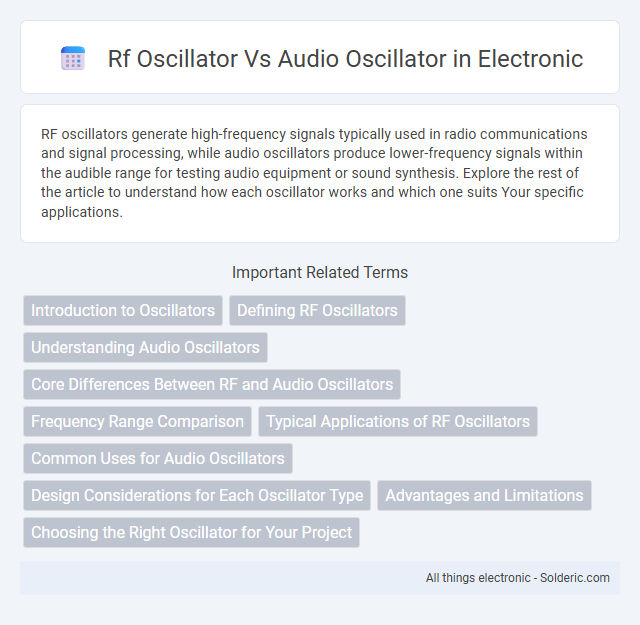RF oscillators generate high-frequency signals typically used in radio communications and signal processing, while audio oscillators produce lower-frequency signals within the audible range for testing audio equipment or sound synthesis. Explore the rest of the article to understand how each oscillator works and which one suits Your specific applications.
Comparison Table
| Feature | RF Oscillator | Audio Oscillator |
|---|---|---|
| Frequency Range | Radio frequencies (kHz to GHz) | Audio frequencies (20 Hz to 20 kHz) |
| Purpose | Signal generation for communication, radar, and RF testing | Audio signal generation for testing, sound synthesis, and audio equipment calibration |
| Output Waveform | Sine wave, sometimes square or pulse | Sine, square, triangle, sawtooth waves |
| Design Components | Inductors, capacitors, quartz crystals, transistors specialized for high frequencies | Resistors, capacitors, op-amps, transistors suited for low frequencies |
| Application Examples | RF transmitters, receivers, oscillators in communication devices | Audio testing equipment, music synthesizers, sound engineering |
| Stability | High frequency stability critical for communication | Moderate stability adequate for audio applications |
Introduction to Oscillators
Oscillators generate continuous wave signals essential for various electronic applications, with RF oscillators producing high-frequency signals typically above 20 kHz for wireless communication, radar, and signal processing. Audio oscillators operate at audible frequencies, generally 20 Hz to 20 kHz, used in audio testing, music synthesis, and sound generation. Understanding the frequency range and application context helps you select the right oscillator type for your specific electronic circuits or projects.
Defining RF Oscillators
RF oscillators generate high-frequency signals typically ranging from 20 kHz to several GHz, essential for wireless communication, radar, and signal processing applications. Audio oscillators operate at much lower frequencies, usually within the audible range of 20 Hz to 20 kHz, and are used for testing audio equipment or creating sound waves. Understanding the frequency range and purpose distinctions between RF and audio oscillators helps you select the right device for radio frequency or audio signal generation needs.
Understanding Audio Oscillators
Audio oscillators generate low-frequency signals within the audible range, typically 20 Hz to 20 kHz, essential for testing audio equipment and sound synthesis. Unlike RF oscillators, which produce high-frequency signals above 20 kHz used in radio communications and signal processing, audio oscillators focus on precision waveform quality and stability for sound applications. Your choice of an audio oscillator depends on desired frequency accuracy, waveform type, and output amplitude suitable for audio testing or music production.
Core Differences Between RF and Audio Oscillators
RF oscillators generate high-frequency signals typically ranging from kilohertz to gigahertz, essential for wireless communication and radio transmission, while audio oscillators produce low-frequency signals within the audible range of 20 Hz to 20 kHz for sound testing and audio applications. The core difference lies in their frequency range and circuit design; RF oscillators often use quartz crystals or LC circuits for stability at high frequencies, whereas audio oscillators commonly utilize op-amps or function generators. Your choice between the two depends on whether you need to work with radio frequencies or audio signals.
Frequency Range Comparison
RF oscillators operate over a broad frequency range from about 3 kHz up to 300 GHz, covering radio frequency bands essential for communication, broadcasting, and radar applications. Audio oscillators generate signals within the audible range, typically 20 Hz to 20 kHz, used for testing audio equipment, sound synthesis, and acoustic research. The key difference lies in RF oscillators supporting high-frequency radio waves, while audio oscillators produce lower-frequency sound waves detectable by the human ear.
Typical Applications of RF Oscillators
RF oscillators are primarily used in wireless communication systems, signal generators, and radar equipment due to their ability to generate high-frequency signals ranging from a few kHz to several GHz. They play a crucial role in frequency synthesis for radio transmitters, local oscillators in superheterodyne receivers, and clock generation in microprocessors and PLL circuits. RF oscillators enable precise signal modulation and demodulation in applications such as RFID systems, satellite communication, and microwave transmission.
Common Uses for Audio Oscillators
Audio oscillators generate low-frequency signals used primarily in sound testing, audio equipment calibration, and music synthesis. They produce stable sine, square, or triangle waves to evaluate speaker performance, signal processing circuits, and audio amplifiers. Your audio projects benefit from these oscillators by enabling accurate waveform generation for both testing and creative sound design.
Design Considerations for Each Oscillator Type
RF oscillators require careful design of frequency stability and low phase noise using high-Q resonators such as crystal or LC tanks, with attention to parasitic capacitances and inductances that can affect high-frequency performance. Audio oscillators prioritize waveform purity and low distortion, often employing Wien bridge or phase-shift circuits with stable amplitude control to maintain frequencies within the audible 20 Hz to 20 kHz range. Thermal stability and power supply noise rejection are critical design factors for both oscillator types but are addressed differently due to their respective operating frequency bands and application requirements.
Advantages and Limitations
RF oscillators provide the advantage of generating high-frequency signals essential for wireless communication, offering stability and precision in radio frequency applications. Audio oscillators excel in producing low-frequency waveforms for testing and audio signal generation, with benefits in simplicity and ease of use but limited to audible frequency ranges. Your choice depends on the frequency requirements and application complexity, as RF oscillators handle high-frequency tasks with better spectral purity, while audio oscillators are more suitable for sound and low-frequency signal testing.
Choosing the Right Oscillator for Your Project
RF oscillators generate high-frequency signals typically used in communication and signal processing, while audio oscillators produce lower-frequency signals for sound synthesis and testing audio equipment. Your choice depends on the application's frequency range and signal stability requirements, with RF oscillators suited for radio transmission and audio oscillators ideal for audio signal generation. Consider factors like frequency accuracy, output waveform, and power consumption to select the right oscillator for your project.
rf oscillator vs audio oscillator Infographic

 solderic.com
solderic.com